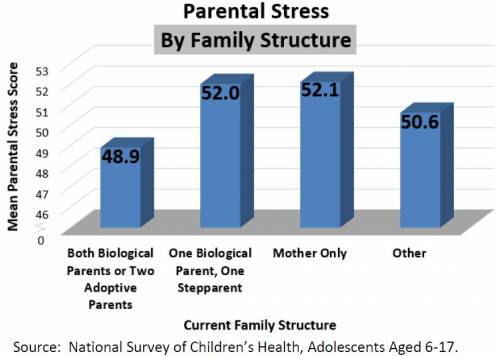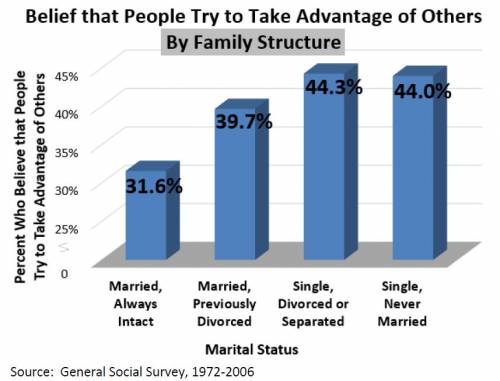Effects of Marriage on Mental Health
Married people are least likely to have mental disorders, 1) and have higher levels of emotional and psychological well-being than those who are single, divorced, or cohabiting.2) Marriage protects against feelings of loneliness.3) Married mothers enjoy greater psychological well-being and greater love and intimacy than cohabiting or single mothers.4) Marriage also has a wide range of benefits for physical health.
1. Anxiety and Stress
Both adults and children in married families suffer less psychological distress than their counterparts in divorced families.5) Married men have lower levels of stress hormones,6) and married women experience less psychological distress.7) Married mothers feel more love and intimacy, less ambivalence, and experience less conflict with their husbands than cohabiting and single women do with their partners.8)
1.1 Related American Demographics
According to the National Survey of Children’s Health, biological parents and adoptive parents who are married report less parenting stress (48.9) than single mothers (52.1), biological parent/stepparent families (52.0), or “other” family structure (50.6) such as single fathers. 9) (See Chart Below)
2. Depression
Those who are married report less depression10) than cohabiting couples.11) Married mothers report less depression, more support from their partners, and more stable relationships than cohabiting mothers.12) Adolescents living with married parents are less likely to be depressed than those in stepfamilies or single-parent families (with or without other adults present).13)
3. Suicide
Married people are least likely to commit suicide.14) Adolescents in divorced families are more likely to commit suicide.15)
4. Happiness
Married people are much more likely to report being happy than cohabiters,16) and those who do not cohabit prior to marriage report having happier marriages than those who do cohabit.17) Married people (those in intact marriages and those who have divorced and remarried) most frequently report being proud of their work.18) Married mothers of infants have the most positive attitudes and report forming better home environments than single and cohabiting mothers.19)
4.1 Related American Demographics
A larger fraction of those raised in an intact family consider themselves “very happy” than those raised in non-intact families.20) (See Chart Below)
5. Drug and Alcohol Use
Married individuals are more likely to cease using marijuana, due in part to improvements in self-control.21) Continuously married adults less frequently report that they sometimes drink too much.22) Married women have fewer alcohol problems.23) African-Americans who are married have lower rates of excessive drinking and drug use.24)
Adolescents from intact married families are less likely to use cocaine than those from divorced families.25) Teenagers from intact families are less likely to begin smoking than those with never-married or divorced single parents.26)
6. Community
Older married couples enjoy more social support than older cohabiters,27) and married mothers enjoy more social support than cohabiting or single mothers.28) Those in intact marriages less often report believing that most people would try to take advantage of others. Married parents spend more on education and less on alcohol and tobacco as compared to cohabiting parents.29)
6.1 Related American Demographics
According to the General Social Survey (GSS), always-intact married adults are less likely than married, previously divorced adults or unmarried adults to believe that most people would try to take advantage of others.30) (See Chart Below)
Benjamin Malzberg, “Marital Status in Relation to the Prevalence of Mental Disease,” Psychiatric Quarterly 10, (1936): 245-261; J. Coyne, M.J. Rohrbaugh, V. Shoham, J.S. Sonnega, J.M. Nicklas, and J.A. Cranford, “Prognostic Importance of Marital Quality for Survival of Congestive Heart Failure” American Journal of Cardiology 88, no. 5 (2001): 526-529. As cited in California Healthy Marriages Coalition, “Healthy Marriages, Mental Health. Research on the Alignment of Marital Outcomes and Mental Health.” Available at http://camarriage.com/content/resources/7b8690b0-784f-46e7-af7d-438a9b064557.pdf. Accessed 25 August 2011.
Susan L. Brown, “The Effect of Union Type on Psychological Well-being: Depression among Cohabitors versus Marrieds,” Journal of Health and Social Behavior 41, no. 3 (2000): 241-255.
Beth A. Hahn, “Marital Status and Women’s Health: the Effect of Economic Marital Acquisitions,” Journal of Marriage and the Family 55, no. 2 (1993): 495-504; Yuanreng Hu and Noreen Goldman, “Mortality Differentials by Marital Status: An International Comparison,” Demography 27, no. 2 (1990): 233-250; Janice K. Kiecolt-Glaser and Tamara L. Newton, “Marriage and Health: His and Hers,” Psychological Bulletin 127, no. 4 (2001): 472-503; L.A. Lillard and C.W.A. Panis, “Marital Status and Mortality: The Role of Health,” Demography 33, no. 3 (1996): 313-327; L.A. Lillard and L.J. Waite, “’Til Death Do us Part: Marital Disruption and Mortality,” The American Journal of Sociology 100, no. 5 (1995): 1131-1156; K. Marcussen, “Explaining Differences in Mental Health Between Married and Cohabiting Individuals,” Social Psychology Quarterly68, no. 3 (1999): 239-257; Steven Stack and J.R. Eshleman, “Marital Status and Happiness: A 17-Nation Study,” Journal of Marriage and the Family 60, (1998): 527-536; K.A.S. Wickrama, et al., “Marital Quality and Physical Illness: A Latent Growth Curve Analysis,” Journal of Marriage and the Family 59, no. 1 (1997): 143-155. All as cited in D. Lees, “The Psychological Benefits of Marriage,” Research Note (2007): 1-4. Available at http://www.maxim.org.nz/files/pdf/psychological_benefits_of_marriage.pdf. Accessed 27 July 2011
M.A. Distel, I. Rebollo-Mesa, A. Abdellaoui, C.A. Derom, G. Willemsen, J.T. Cacioppo, D.I. Boomsma, “Familial Resemblance for Loneliness,” Behavior Genetics 40, no. 4 (2010): 480, 488,490.
W.R. Avison, J. Ali, and D. Walters, “Family Structure, Stress, and Psychological Distress: A Demonstration of the Impact of Differential Exposure,” Journal of Health and Social Behavior 48, (2007): 306.
Nicholas Zill, “Parenting Stress and Family Structure,” Mapping America Project. Available at http://marri.us/wp-content/uploads/MA-34-36-160.pdf
Kristen S. Lee, and Hiroshi Ono, “Marriage, Cohabitation, and Happiness: A Cross-National Analysis of 27 Countries,” Journal of Marriage & Family 74, no. 5 (2012): 961-962.
Patrick F. Fagan and Althea Nagai, “Intergenerational Links to Happiness: Family Structure.” Available at http://marri.us/wp-content/uploads/MA-49-51-165.pdf. Accessed 26 August 2011.
Susan L. Brown and Lauren N. Rinelli, “Family Structure, Family Processes, and Adolescent Smoking and Drinking,” Journal Of Research On Adolescence 20, no. 2 (2010): 264, 266.
Patrick F. Fagan and Althea Nagai, “’Belief That People Try to Take Advantage of Others’ by Marital Status.” Available at http://marri.us/wp-content/uploads/MA-88-90-178.pdf. Accessed 26 August 2011.This entry draws heavily from 164 Reasons to Marry.
Discover more from ReviewFitHealth.com
Subscribe to get the latest posts sent to your email.


